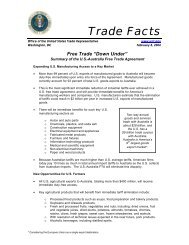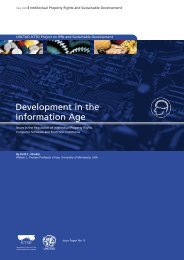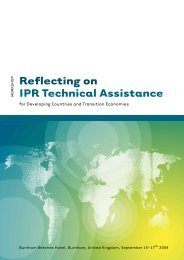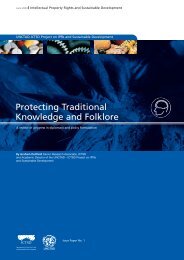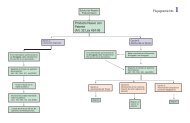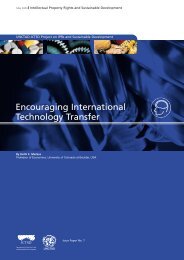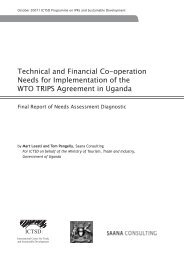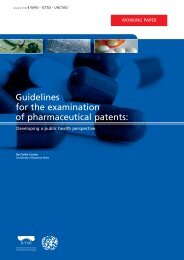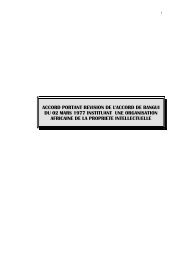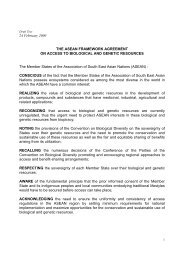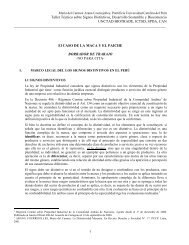Governance and Micropolitics of Traditional ... - IPRsonline.org
Governance and Micropolitics of Traditional ... - IPRsonline.org
Governance and Micropolitics of Traditional ... - IPRsonline.org
You also want an ePaper? Increase the reach of your titles
YUMPU automatically turns print PDFs into web optimized ePapers that Google loves.
4. THE KNOWLEDGE AND RESOURCES OF INDIGENOUS AND LOCAL<br />
PEOPLES.<br />
During one interview with Pr<strong>of</strong>essor Yos Santosombat (17 th May 2005), a highly regarded<br />
anthropologist with over a decade <strong>of</strong> fieldwork with the chao khao (indigenous <strong>and</strong><br />
sometimes immigrant ‘hill tribes’ as they are <strong>of</strong>ten stereotyped) <strong>of</strong> northern Thail<strong>and</strong>, a series<br />
<strong>of</strong> complicated questions were asked about access <strong>and</strong> benefit-sharing, prior informed consent<br />
<strong>and</strong> databases for traditional knowledge. At the end <strong>of</strong> the sequence <strong>of</strong> these questions he<br />
remarked:<br />
…Such things do not matter if there is no continued local practice. I worry most about<br />
the disruption <strong>of</strong> local practice.<br />
Indeed, if traditional practices are lost, then things like databases <strong>and</strong> genebanks only become<br />
useful as a static source <strong>of</strong> prior art, or a genetically static sample. So far, the focus <strong>of</strong> this<br />
paper has discussed government policies <strong>and</strong> laws which are oriented more towards the<br />
protection <strong>of</strong> genetic resources <strong>and</strong> traditional knowledge from misappropriation. However<br />
the day-to-day threats to the livelihood <strong>and</strong> culture <strong>of</strong> indigenous <strong>and</strong> local communities<br />
seem, at times, far removed from these complicated ‘technical’ issues.<br />
This section attempts to address the complexity <strong>of</strong> traditional knowledge, problems associated<br />
with defining <strong>and</strong> transferring down-scale some legal notions that are poorly understood for<br />
the ‘local’ context, <strong>and</strong> threats to continued local practice. The first section discusses<br />
ambiguities over the identity <strong>of</strong> an indigenous or local community, an examination <strong>of</strong> the<br />
meaning <strong>of</strong> traditional practice through a few case studies, an analysis <strong>of</strong> the propertyresource-intellectual<br />
property nexus, <strong>and</strong> threats to continued practice.<br />
4.1 Identity <strong>of</strong> Indigenous <strong>and</strong> Local Communities<br />
It is rarely clear exactly which groups fit within the scope <strong>of</strong> ‘indigenous peoples’, no matter<br />
which country. One common difficulty with the distinction is in regards to whether a<br />
dominant population can indeed be considered ‘indigenous’. In Thail<strong>and</strong>, the word indigenous<br />
is unclear <strong>and</strong> could refer to the dominant population, or to smaller tribal groups.<br />
It is also <strong>of</strong>ten unclear to where the boundaries <strong>of</strong> a ‘community’ may be extended.<br />
Community has a great deal to do with self-recognition as well as external or trans-local<br />
recognition <strong>of</strong> the unity <strong>of</strong> a group <strong>of</strong> people. Self-recognition may at times be at odds with<br />
external recognition, the fringes <strong>of</strong> community (in terms <strong>of</strong> l<strong>and</strong>, population <strong>and</strong> culture) may<br />
be unclear, <strong>and</strong> the holism <strong>of</strong> a communitarian ideal will also be dependant upon<br />
individualism. The internal sense <strong>of</strong> community may be dislocated by regulatory or forced<br />
actions by government, industry, or other groups. Thus a variable view <strong>of</strong> community is<br />
essential.<br />
Clearly then, finding legal <strong>and</strong> practical means for the recognition <strong>of</strong> indigenous <strong>and</strong><br />
community rights must take into account some <strong>of</strong> these dynamics. Box 4 outlines some <strong>of</strong> the<br />
definitions that have been used in international law <strong>and</strong> national laws. The last definition is<br />
that used by the Thai PVP Act such that local communities can register a local plant variety<br />
for protection.<br />
77






